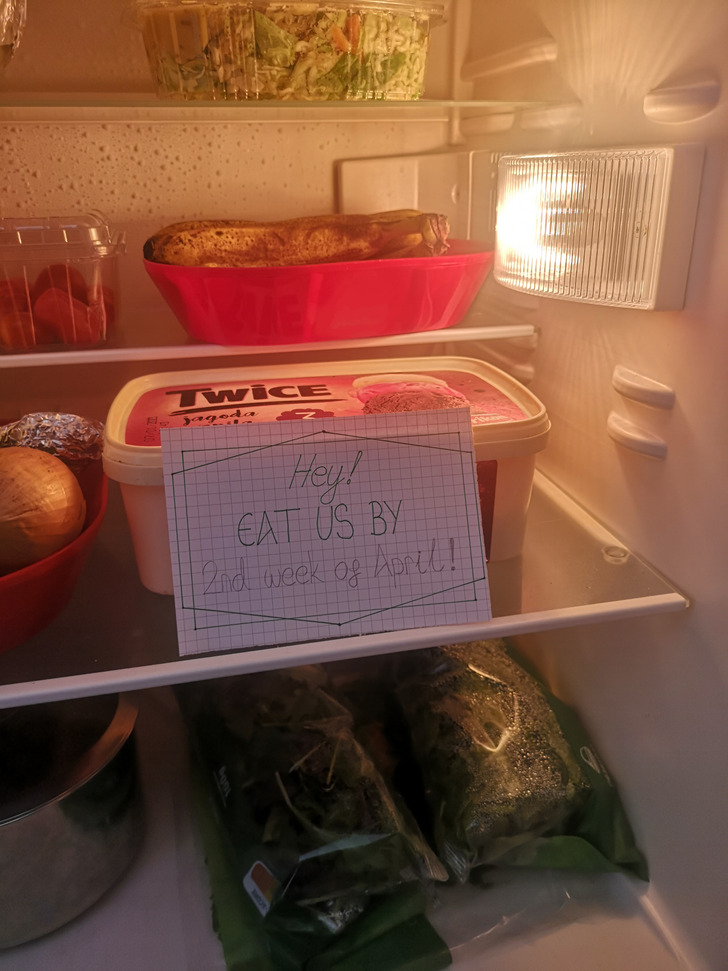Kim Kardashian Is Trolled for Editing Her Recent Pic, and It’s Taking the Internet by Storm

Food waste in the US comprises the largest category of material in municipal landfills and makes up about 30%-40% of the country’s total food supply, according to the FDA. That means that over a third of all the food is wasted. Luckily, there are plenty of easy steps we can take to change that.
Here at Bright Side, we love taking care of our environment, so we put together some storage tips to reduce the amount we waste at home. For bonus eco-friendliness, check out a zero-waste recipe at the end.

You’re probably already familiar with the “eat me first” box. This is a variation on that idea, for those of you who feel like it’s a hassle to regularly transfer stuff to the “eat me first” box. You can save yourself some trouble by having 2 or 3 boxes with replaceable labels (or dry-erase ones).
Write a time, like “last week of May,” and store the things that match that “best-before” or “use-by” time. Such mini-deadlines can help you be more accountable because you’ll have a specific time instead of a vague idea, like “This should be eaten sometime soon.”
Take a look at your fridge and/or its manual. You want to know which drawers have higher humidity levels and which have lower ones. Also keep in mind that it’s coldest at the back or bottom of the fridge, and the door is the warmest place because we open it all the time.
Put veggies that can wilt into the high humidity drawer. Leafy greens, carrots, broccoli, cauliflower, and cucumbers go here. Veggies that can rot (peppers and mushrooms) go into the low humidity drawer. Most fruits also go there. Some produce provokes faster ripening and should be kept away from other produce, so put those in a separate section of your fridge.
Leftovers are easy to disregard for various reasons until they go bad and have to land in the trash. One effortless way to avoid that is to have a dedicated container or shelf for them right in your line of sight. If you use a container, choose a transparent one so that you can tell at a glance what’s inside.
One common reason why we all waste food is that we overbuy. Often, we don’t know exactly what we have in the fridge and pantry, so we grocery shop off the tops of our heads and get easily fooled by supermarket tactics. That way we end up with too much stuff and no idea how to use it up.
Set up an inventory list in a very obvious place in your kitchen so you’ll have to see it every day, like on the fridge door. Write down the foods you eat most often and how much of each you have. Then add other groceries that aren’t your go-tos but that are there at the moment. That way, food won’t have a chance to be forgotten and spoil, and you can save money on buying things you don’t actually need.
It’s easy for baked goods to go dry or stale. Surprisingly, keeping them in the fridge can make it worse, but freezing is a great alternative. When you have leftover bread, slice it while it’s still relatively fresh, pack it up, and freeze it.
Later on, you can thaw separate slices or pop them into a toaster. If your spare bread isn’t fresh enough that you’d want to eat it later, you can reuse it to make croutons, French toast, or breadcrumbs for use in other dishes.
Clear containers are enormously helpful in keeping stock of your food. Here’s a low-effort idea: whenever you use up a jar of something, wash that jar, remove the label, and replace one other container with it.
This way, you kill 3 birds with 1 stone: you get a nice see-through container for your food, you replace an older one that’s probably worn out by now, and you swap out plastic for glass, which is healthier and more eco-friendly.
If you love organizing, you probably make your own labels. They’re great for keeping track of what’s stored where, so why not take it up a notch? Add some extra information to your labels.
Along with the food name, consider adding the date it was made (if you store homemade goods), or the best-by and use-by dates on things you freeze without their original packaging (like meats). Add allergen warnings if someone in your home has intolerances. Here’s a handy guide on that.
Ziploc bags are great for airtight freezing, but they can store much more than loose veggies. For example, you can fill them with minced meat, ready-made salad mixes, fresh herbs, and even sauces and similarly creamy stuff. One nifty hack for this storage solution is to divide the contents of the bag before putting it on ice.
Let’s say you’re freezing a bag of your favorite tomato paste with herbs. Close the Ziploc, lightly press to make the paste spread evenly throughout, and then use the blunt side of a knife or something similar to make neat sections. When you need to use it, no need to thaw the whole thing: just break off as many sections as you need and keep the rest frozen, hassle-free.
This is aimed less at individual groceries or produce and more at cooked leftovers, ready-made meals, stock, and the like. Sometimes it’s annoying to single out a single meal or 2 from the whole container, especially if it needs heating up.
To make this more convenient, portion the food before storing it. Like with the Ziplocs, just single out the amount you need and leave the rest stored. This is handy for bulk foods, too: split the cereals into breakfast doses or portion off the pasta by how much you cook for a typical lunch. There’s less waste if you know how many more meals of that food you have and you can plan your menus and shopping accordingly.
This sounds completely counterintuitive, we know. But hear us out for a bit. Most of us don’t really like seeing an understocked fridge or pantry, right? If the space that’s meant to hold our food supply looks half-empty, it can make us anxious. But what if that space is bigger than we actually need?
To overcome the anxiety, we buy more food to fill it up, and we don’t get around to using it all, not to mention the fact that things get shoved to the back and forgotten. We understand that you can’t exactly reduce your pantry, but a smaller fridge could be a great idea to invest in.
Here’s a neat way to reduce your food waste even further when you’re prepping vegetables for a dish.
You can use it for soups, sauces, risotto etc., and then you can compost the scraps after straining them out.
Have you tried any of these storage tricks before? What’s your favorite way to reduce food waste in your home?











